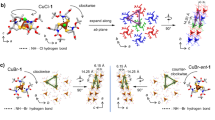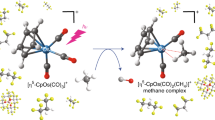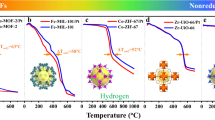Abstract
ACCORDING to Halpern1 the effect of complex forming ligands on the activation of molecular hydrogen by metal ions can be explained by the following scheme:  Thus the heterolytic splitting of hydrogen is the consequence of the concerted action of the central metal ion and the ligand bond. Great activation effect can be expected from the ligands which, although weak acids, form unstable complexes with the metal ion, that is, which do not screen the positive charge partly responsible for the heterolytic splitting. These requirements are contradictory in general, being a parallelism between the proton affinity and the complex forming tendency of the ligands. In the case of silver(I), the reduction of which by hydrogen was thoroughly investigated by Halpern et al.2–5, the fluoride ion fulfils the requirements mentioned: although hydrogen fluoride is a rather weak acid (pK = 3.4), the fluoride ion forms an unstable monofluorosilver(I) complex6,7.
Thus the heterolytic splitting of hydrogen is the consequence of the concerted action of the central metal ion and the ligand bond. Great activation effect can be expected from the ligands which, although weak acids, form unstable complexes with the metal ion, that is, which do not screen the positive charge partly responsible for the heterolytic splitting. These requirements are contradictory in general, being a parallelism between the proton affinity and the complex forming tendency of the ligands. In the case of silver(I), the reduction of which by hydrogen was thoroughly investigated by Halpern et al.2–5, the fluoride ion fulfils the requirements mentioned: although hydrogen fluoride is a rather weak acid (pK = 3.4), the fluoride ion forms an unstable monofluorosilver(I) complex6,7.
This is a preview of subscription content, access via your institution
Access options
Subscribe to this journal
Receive 51 print issues and online access
$199.00 per year
only $3.90 per issue
Buy this article
- Purchase on SpringerLink
- Instant access to full article PDF
Prices may be subject to local taxes which are calculated during checkout
Similar content being viewed by others
References
Halpern, J., J. Phys. Chem., 63, 398 (1959).
Webster, A. H., and Halpern, J., J. Phys. Chem., 60, 280 (1956).
Webster, A. H., and Halpern, J., J. Phys. Chem., 61, 1239 (1957).
Webster, A. H., and Halpern, J., J. Phys. Chem., 61, 1245 (1957).
Halpern, J., and Milne, B. J., Proc. Second Intern. Cong. Catalysis, Paris, 1, 445 (1960).
Leden, I., and Marthen, L., Acta Chem. Scand., 6, 1125 (1952).
Connick, R. E., and Paul, A. D., J. Phys. Chem., 65, 1216 (1961).
Author information
Authors and Affiliations
Rights and permissions
About this article
Cite this article
BECK, M., GIMESI, I. & FARKAS, J. Effect of Fluoride Ion on the Activation of Molecular Hydrogen by Silver(I). Nature 197, 73 (1963). https://doi.org/10.1038/197073a0
Issue date:
DOI: https://doi.org/10.1038/197073a0



